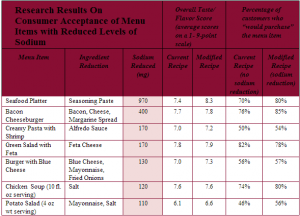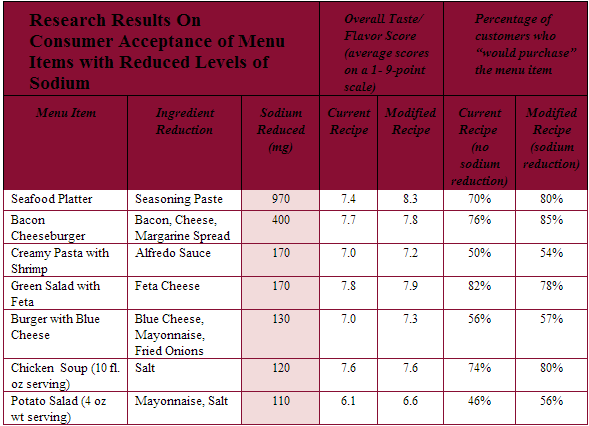 New research led by Healthy Dining and funded by the National Cancer Institute (NCI), a division of the National Institutes of Health (NIH), reveals that restaurant consumers accept, and in most cases even prefer, menu choices that were reduced in sodium content. Healthy Dining’s registered dietitians and research team reduced salt and other high-sodium ingredients in several popular menu items at four large restaurant chains and tested the menu items with 1,200 frequent restaurant customers.
New research led by Healthy Dining and funded by the National Cancer Institute (NCI), a division of the National Institutes of Health (NIH), reveals that restaurant consumers accept, and in most cases even prefer, menu choices that were reduced in sodium content. Healthy Dining’s registered dietitians and research team reduced salt and other high-sodium ingredients in several popular menu items at four large restaurant chains and tested the menu items with 1,200 frequent restaurant customers.
The NIH-funded research was conducted by Healthy Dining in collaboration with research advisors David L. Katz, MD, MPH, founding director of the Prevention Research Center at Yale University, Valentine Yanchou Njike, MD, MPH, assistant director of the Prevention Research Center at Yale University, and Harry Lawless, PhD, Professor Emeritus at Cornell University.
“The results of the Healthy Dining research are especially significant in light of the recent news that the Food and Drug Administration is preparing to issue voluntary guidelines to restaurants to lower sodium levels,” said Anita Jones-Mueller, MPH, Healthy Dining president and founder. “The good news is that many restaurants are already making impressive strides in reducing sodium content, and the research we are conducting is demonstrating that consumers are rating menu items with less sodium as high as – and in most cases higher than – the current versions in terms of overall flavor.”
The Healthy Dining study focused on simply reducing the amounts of target ingredients — and not reformulating or adding additional ingredients — for popular menu items like burgers, seafood, pasta, soups and salads. The results below show that every menu item with sodium levels reduced was rated as high as or higher than the original version in terms of flavor.
“It’s exciting to see that the menu items with less sodium rated as high as or higher than the original versions in terms of flavor. Additionally, for most of the tested menu items, the restaurant guests were more likely to purchase the menu items with less sodium,” said Esther Hill, PhD, Director of Research for Healthy Dining. “And keep in mind that the taste testers did not know that the sodium had been reduced. Rather, they were simply rating the overall flavor. These results should give restaurants and food suppliers confidence about continuing to reduce sodium.”
“While there is debate about optimal levels of dietary sodium, there is no doubt that the typical American diet contains too much,” said David L. Katz, MD, MPH. “This research is demonstrating that sodium can be addressed, while preserving good taste and enjoyment.”
Healthy Dining has also developed the “Sodium Savvy” program on HealthyDiningFinder.com to make it easier for restaurant goers to find menu choices that are lower in sodium at thousands of restaurants nationwide. To qualify for the Sodium Savvy icon, a menu item must meet the following requirements:
- Entrée: 750 mg of sodium or less
- Appetizer, Side Dish or Dessert: 250 mg of sodium or less
More than 800 menu items featured on HealthyDiningFinder.com qualify for the Sodium Savvy icon. These items also meet the Healthy Dining nutrition criteria and emphasize lean proteins, vegetables, fruits, whole grains and unsaturated fats.








